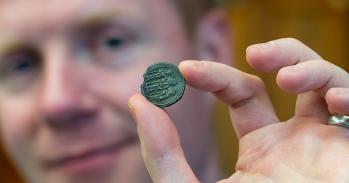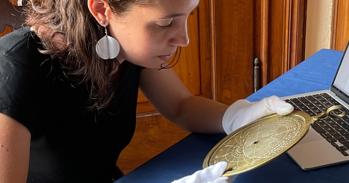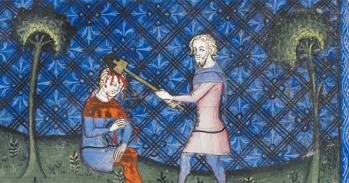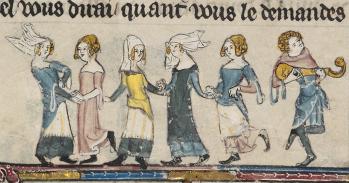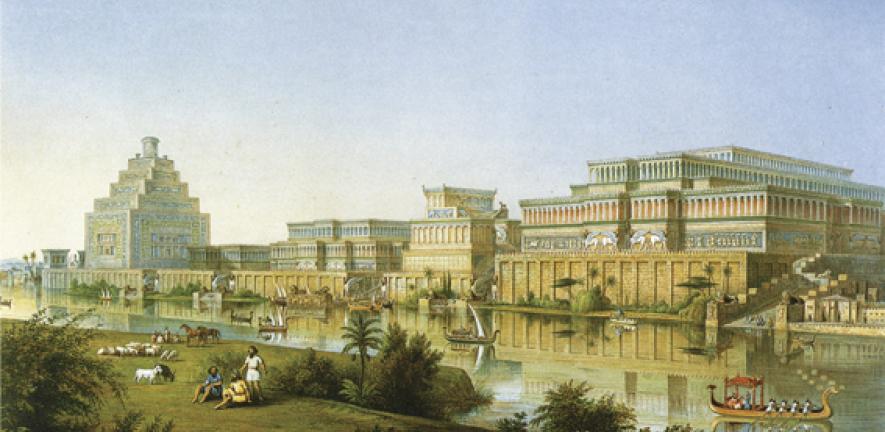
Examples of the world’s oldest science and literature – 2,500-year-old clay writing tablets – hold clues as to how ancient scholars acquired and used knowledge, as Dr Eleanor Robson explains.
Examples of the world’s oldest science and literature – 2,500-year-old clay writing tablets – hold clues as to how ancient scholars acquired and used knowledge, as Dr Eleanor Robson explains.
Most temples and palaces, and many private households, made collections of tablets and writing boards containing what we would now call science and literature, magic and religion.
Dr Eleanor Robson
Many have heard of the Library of Alexandria, founded in the 4th century BC on the northern coast of Egypt by the Ptolemaic successors of Alexander the Great, but very little of it remains: no books, no buildings, nothing but a confusing mass of anecdotes and legends of its past glories. Likewise, the ancient Greek Library of Pergamon, which reputedly flourished in the 3rd century BC and is today a series of ruins, and the holdings of the famous Villa of the Papyrii in Herculaneum, carbonised following the eruption of Vesuvius in 79 AD.
Yet, in nearby Assyria and Babylonia – roughly the north and south of modern-day Iraq – we encounter the opposite problem: such an overwhelming quantity and complexity of primary data about ancient libraries that, until recently, it has been virtually impossible to make sense of the tale they are telling. Uncovering this story has been the goal of ‘The Geography of Knowledge in Assyria and Babylonia’ research project I have been running since 2007, with funding from the Arts and Humanities Research Council.
From jottings to compendia
In ancient Iraq and its neighbours, most writing 2,500 years ago was in cuneiform (or wedge-shaped) script on durable clay tablets, which have withstood the ravages of the millennia much more robustly than perishable media such as parchment, papyrus and wooden writing boards.
The tablets were first used to document the economic activities of organisations of the Sumerian civilisation in southern Iraq in the late 4th millennium BC, a few centuries before the development of hieroglyphs in Egypt. Memorisation was a key part of scribal training, and much of these earliest scholarly writings survive only as ephemera – the jottings of students and apprentices using a reed stylus as they repeated and recalled passages by rote.
By the 1st millennium BC though, as the body of knowledge and speculation about the world accrued and was organised into systematic compendia, knowledge was increasingly transmitted in fixed, written formats as well as in the memories of the learned.
Over 40 such assemblages or ‘libraries’ of scholarly tablets have been excavated from across Assyria and Babylonia. Most famous – and by far the largest – is the 20,000-tablet Assyrian royal library from 7th-century BC Nineveh in northern Iraq, found by happenstance in the early days of exploration in the 1840s and now housed in the British Museum.
But most of the libraries comprise a few dozen or a few hundred tablets, typically stored (or abandoned) in a single room or courtyard of a house or temple, filed in built-in pigeonholes, large terracotta jars, or long-perished baskets or shelves. The latest date from the last few centuries BC – some time after the founding of the Library of Alexandria – at the tail end of cuneiform culture.
Libraries of knowledge
The project, based in the Department of History and Philosophy of Science and staffed by Dr Marie-Françoise Besnier, Dr Graham Cunningham and Dr Greta Van Buylaere, is currently creating online editions of the tablets from four of the 40 libraries, spanning the period 700–200 BC, to better understand the knowledge cultures of ancient Assyria and Babylonia on their own terms.
Where previous endeavours have focused on editing works such as The Epic of Gilgamesh or the great celestial omen compendium Enuma Anu Ellil, based on writings from a whole range of different periods and contexts, our aim is to restore context and coherence to cuneiform scholarship by studying it holistically, library by library.
We are as interested in the materiality of the tablets, and the buildings they were found in, as in the texts themselves. And the text often comprises not just the composition itself but also a so-called colophon, which typically recorded who wrote the tablet, why and when, and for whom. Colophons enable us to construct networks of ownership, apprenticeship and patronage of knowledge in cuneiform culture, revealing some of the mechanisms by which it was created, communicated, transformed, used and eventually abandoned.
Why, for instance, was a collection of about 400 scholarly writings abandoned outside a well-to-do house in Huzirina, a small town in provincial Assyria, hundreds of miles from the political and intellectual centre of the empire? Their colophons tell us that the collection was built up gradually over the 7th century BC, copied or composed by four generations of priests of the god Zababa but also by about 30 other men, typically sons of local officials. However, they often produced low-quality texts. These and other clues lead us to hypothesise that the Huzirina collection was the output of a small provincial school for the middle-ability sons of middle-ranking imperial bureaucrats. Carefully buried for safeguarding in 610 BC, as the Medes and Persians overran the nearby Assyrian city of Harran in their final phase of conquest, the library was never returned for.
Anu-belshunu’s horoscope
Remarkably, the piecing together of individual stories discovered in the tablets is providing insight into how indigenous knowledge adapted to the end of local rule, and with it royal patronage, and how it managed to survive for nearly half a millennium after the Persian conquest of Babylonia in 539 BC.
One such story concerns a man named Anu-belshunu who, some time in the late 3rd century BC in the Babylonian city of Uruk, commissioned a horoscope giving his date of birth as 28 December 248 BC. The horoscope was itself a new form of predicting the future, formerly a royal preserve through celestial divination, but since the 5th century increasingly available to a private clientele.
As it turns out, Anu-belshunu was no random punter. He too was a scholar and priest, who lived and worked in an increasingly small community of traditionalists in and around the main temple of Uruk, as the rest of the city became increasingly Grecophone and Hellenophile.
The remains of a library and archive found in the temple, and elsewhere in Uruk, show that Anu-belshunu, his sons and grandsons, performed and documented the daily, monthly and yearly rituals for the care and feeding of the Babylonian gods. But they also calculated with mind-boggling accuracy the future timings of major celestial events such as lunar eclipses, the better to serve the gods through the accurate timing of ritual performance – and presumably the better to maintain the dwindling community of worshippers. Their family documents show them marrying, inheriting and trading with just six other like-minded families. Thus we see Babylonian mathematical astronomy in its original context: not as a fledgling ‘exact science’ but as a defensive (and ultimately doomed) response to rival traditions of knowledge and belief.
A new library is born
We are now three years into the five-year project. The tool that has made this research possible is Oracc(http://oracc.org/), an open-source toolkit and workspace for the edition and linguistic annotation of all sorts of cuneiform texts. It was created by project co-director Professor Steve Tinney of the University of Pennsylvania, and is managed as a cooperative by the two of us and Professor Niek Veldhuis of University of California, Berkeley.
Oracc has enabled the Cambridge team to create the Corpus of Ancient Mesopotamian Scholarship (http://oracc.org/cams/), presenting our sources in alphabetic transliteration and English translation, with full glossaries and sophisticated search and analysis facilities. Oracc now hosts about a dozen other projects too, bringing together a scattered worldwide community of researchers to develop a rich resource on three millennia of cuneiform culture that can be used in a multitude of ways by specialists, students and newcomers alike.
For more information, please contact Dr Eleanor Robson (er264@cam.ac.uk) at the Department of History and Philosophy of Science.
This work is licensed under a Creative Commons Licence. If you use this content on your site please link back to this page.


